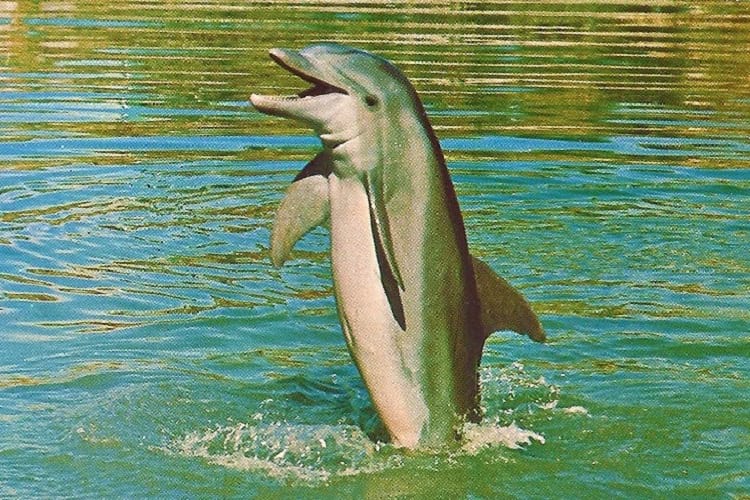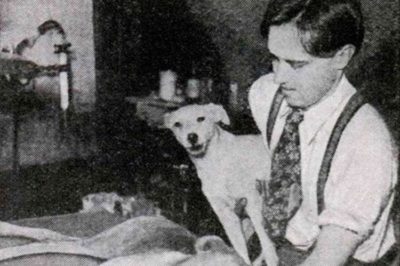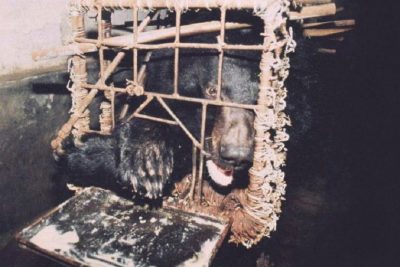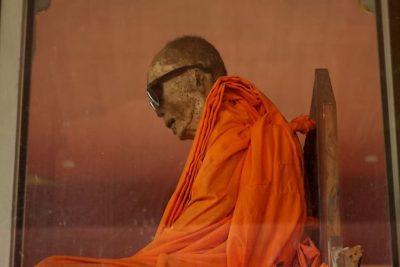The post Animal Suicide: Do Animals, Like Humans Resort to Ending their Own Lives? appeared first on .
]]>
Animal Suicide: Kathy, one of the five bottlenose dolphins that were part of a famous television show called Flipper. The dolphin reportedly committed suicide after being depressed for a long time. (1950sUnlimited / Flickr)
Humans commit suicide, is a given. Do nonhuman animals commit suicide? Well, that’s not a given. Generally speaking, it’s a moot point. A human contemplates on past, present and future. He may seek closure in self-inflicted death. Animals, ostensibly, live in present with limited hindsight and foresight. So, why would they want to die? But, the ground realities reveal that suicide could be a way with non-humans as well.
Animal Suicide: Dogs and horses have done it
Man’s best friend, a dog, was in news in 1845, for committing suicide. The Illustrated London News reported that a dog of Newfoundland breed lay low for a couple of days, and then, threw itself in water, attempting to drown. It was rescued. But it rushed once again to deep waters and was rescued yet again. This exercise continued for long. In the long last, dog succeeded in drowning to death, something that he was dead bent to accomplish. Another case of a chain of canine suicides was highlighted by this portal under the head, ‘Overtoun Bridge from where dogs leap to their deaths’. Despite tangible holes in suicide theory, it is hard to ignore that animals too may choose to die, out of their own free will.
Consider man’s second-best friend, horse. Aristotle (384-322 BC), described one which jumped into a gorge and killed self. The horse had unwittingly mated with its biological mother. A case like Oedipus, the mythical king who unwittingly married his biological mother. When the couple realized the truth of their relationship, both were full of remorse. The lady killed self, and Oedipus renounced the world.
Grief/monotonous existence/choice of a less painful death, have triggered animal suicides
The list of suicide-prone animals is long and mindboggling. Dogs prostrating at the graves of their dead masters and dying. A cat, unable to bear the grief of her dead kittens, chooses to die. A herd of cattle, as recently as 2009, jumps off a cliff in Swiss Alps over a period of 3 days. A deer jumps to death over a slope, preferring to die by a bone-crushing fall rather than fall to hunting dogs.
The suicide of a dolphin, star of the 1960 television show, Flipper, made waves. It is believed that the dolphin grew tired of monotonous life and decided to die. Dolphins are an intelligent creature. They have the ability to observe their thought processes and choose one that suits them best at a particular point in time. They are also unique in being voluntary breathers, unlike humans and other animals who are involuntary breathers. Dolphins breath consciously whereas for other life forms breathing is automatic, uncontrolled, reflex action. That means the dolphin may decide not to breathe till it dies from lack of oxygen. Since such observations can’t be reproduced in experimental conditions, it remains a tentative finding. Nevertheless, this self-induced death of a dolphin is a strong argument in favour of animal suicides.
Suicide bombers do exist in the animal kingdom
Further, there are some life forms which act as suicide bombers. The objective though, is not self-centred, as in suicide, but is self-denial for a larger good. For example, the exploding ants of Malaysia. These ants blow their head or abdomen (autothysis) in the face of a threat. The blow scatters a paste which traps and kills the threat. Thus, a suicide/self-sacrifice saves fellow ants from an enemy. A similar defence is characteristic of a termite (Globitermes sulphurous). It catches hold of the intruder/enemy and pumps its (termite’s) abdomen to release glue which spills over both the lives pitted against each other. The glue hardens upon coming in contact with air, killing them both. Likewise, pea aphid blows up its body to scare, even kill a predator, to save its commune. In what’s closest to committing suicide, it may surrender to a natural parasite, the wasp, to lay eggs on its body. Young wasps feed on aphid body, killing it in the process of growing up. A volunteer aphid thus barters its life to buy protection for the rest of the aphid group from wasp attack. Much like the grandma story of a village and a demon. To contain demon to lesser harm, one villager would volunteer to walk to the demon’s cave every day, and offer himself as food to the demon. That would keep the demon in good humour and save the rest of the village from demon’s wrath.
Self-sacrifice could be suicide by default
Consider self-sacrificing crab spider. It feeds her young ones with her unfertilized eggs. The taste of eggs hooks young ones to the taste of their mother’s body. And the mother is devoured, bit by bit, till it goes lifeless. Matriphagy, the act of feeding on mother’s body, is also observed in some species of scorpions, insects and amphibians. This may be a case of maternal care gone awry but does prove that there is a thin line that separates life and death. If self-preservation was a baseline of animal behaviour, as generally believed, such cases of self-denial wouldn’t be seen among animals. Can these instances, be construed to mean suicides?
Man, unlike animals, may philosophise to choose death
Is suicide a consequence of physical factors? If yes, there are parallels between humans and non-humans. Like, the monotony of existence, perceived pain and tragedy, a drug or substance-induced fatal attraction, etc. Risk of suicide goes up significantly in a man living on anti-depressant drugs. That’s a physical factor prompting suicide. But it is well known that metaphysical factors are significant drivers of human suicide. An IAS officer Mukesh Pandey makes a detailed video of him explaining why he is about to commit suicide. The officer isn’t bogged down by any pain or tragedy, but feels, vaguely, that life isn’t worth living. Does such a metaphysical angle apply to animals as well? Can animals contemplate that life isn’t worth living? Well, as of now, we have no way of knowing.
The mystery of dog-suicides in Scotland remains unsolved
For dog suicides at Overtoun Bridge in Scotland, one explanation is that dog being colour-blind, can’t separate bridge from surrounding greenery, and trips in the intervening space. Another view is that the smell of rodents living in the downside of the bridge lured the canine for a fatal jump. No cause-effect relationship has been established till date and dogs leaping to death from bridge remain a mystery. In stressful situations, scorpions sting their own selves and die. Sceptics say that a fearful scorpion goes sting-stabbing recklessly, and swirling at the same time. And, in an error of judgement, stings its own body and dies. A case of self-defence gone haywire. Were the dogs jumping off the Overtoun bridge doing so in some kind of self-defence?
Can one life use another for its own survival?
Could there be something that programmed the canines, in the above example, to go for daredevil jumps? Can a parasite programme the host animal to go daredevil? There is one interesting case. The infection of a protozoan, Toxoplasma gondii, in the brain of rat. It programs rat to go daredevil and for a purpose. The protozoan parasite needs the body of a cat to complete its life cycle. Because it can reproduce sexually only in a cat’s biosystem. So, what does it do to reach to a cat which a normal rat will always avoid? The parasite hijacks the rat’s neuro-mechanism which helps it remain away from the cat. The infected rat, so to say, is reprogrammed to be attracted to a cat. That obviously makes it easy prey for its natural predator, and the parasite thus gains access to the cat’s body. Could there be more such cases of one life driving another to the path of self-destruction?
Overall, suicide in animals remains an enigma
What is crystal clear is this that sentience is part of animal psychology, like it is of a human being. Both are aware of life, pain and crisis situations. Both may choose death over life in a particular set of circumstances. But suicide is not the same thing as dying for one’s community or fellow beings. It ought to be a closure for a suffering or an unacceptable status of life. Such closure is clear in human suicides as it is communicated by the subject before dying or inferable from cogent circumstantial evidences. No such so closure can be inferred in animal suicides as animal-human communication is extremely limited. Moreover, the metaphysical side of suicide makes it a subject beyond the reach of scientific investigation. Therefore, it is hard to prove, as well as to disprove, that animals commit suicide. Doubtless, there are radical differences in the thought process of humans and non-humans. Suicide, seemingly, is not one of those differences. Or, maybe, we should wait till a standard definition of suicide is drafted.
Enjoyed this article? Also, check out “Overtoun Bridge: A Mysterious Site from Where Dogs Leap to Their Deaths“.
Fact Analysis:
STSTW Media strives to deliver accurate information through careful research. However, things can go wrong. If you find the above article inaccurate or biased, please let us know at [email protected].
RELATED
The post Animal Suicide: Do Animals, Like Humans Resort to Ending their Own Lives? appeared first on .
]]>The post Thich Quang Duc’s Self Immolation – The Vietnamese Buddhist Monk Who Set Himself on Fire appeared first on .
]]>
Thích Quảng Đức after setting himself on fire (Colourised). (Malcolm Browne / AP)
Even if you are not very familiar with Vietnam’s history, you may have come across the famous photograph of a Buddhist monk seated on a Saigon street, engulfed in flames. It is one of those shocking images that, once seen, is hard to erase from the memory. You might wonder what the person taking the photograph was thinking at the time and what the person undergoing the unbearable act of self immolation was feeling. The monk was Thích Quảng Đức, a Vietnamese monk of the Mahayana Buddhist sect, and his self-immolation on 11 June 1963 on a busy street intersection in Saigon was a planned public protest against the anti-Buddhist policies and persecution of Vietnam’s Roman Catholic President Ngo Dinh Diệm.
The photograph was taken by an American journalist named Malcolm Browne and he later received the Pulitzer Prize for capturing the monk’s last moments.
Persecution of the Buddhists in Vietnam
To understand how a Roman Catholic minority could persecute a nearly 80 percent Buddhist majority, we will need to go back to Vietnam’s colonial past. The French ruled over the country from 1884 to 1954 and one of their ‘civilizing’ policies was to enforce their Roman Catholic faith on to the traditionally Buddhist Vietnamese people.
They showed more favour towards the Vietnamese that knuckled under and converted to Roman Catholicism than to the Vietnamese that resisted all “civilizing” attempts and clung stubbornly to their ancient faith.
If you wanted to advance in your career, especially in a government post under the colonial rulers, you would have higher chances of managing it if you renounced Buddhism and became a Roman Catholic. Many Vietnamese took the practical point of view and switched their religions. It is entirely possible, of course, that some of them may have been genuinely convinced that along with the financial windfall, it would bring them a spiritual bonanza as well.
In any case, so by the time the nationalists ousted the French and Ngo Dinh Diệm became the President, there was a Roman Catholic elite in the government and the years of colonial rule had sufficiently bamboozled them into imagining that religion mattered more than a common shared ancestry and cultural heritage. They continued the French policy of assuming a superior attitude and looking down on the nation’s Buddhist population.
If you were a Buddhist in Vietnam at the time, you would face difficulty in securing a government job, and, once you did, you would find yourself being passed over for promotion. It was the same story if you were in the Vietnamese army. In the rural areas, the government could force you to leave your village and move to a less favourable location. They could prevent you from receiving the aid that the US Americans sent to the Vietnamese people.
They could refuse to give you the arms and ammunition that they distributed to Roman Catholic village militias for self-defence purposes, and they would not interfere when these latter militias harassed you, looted your wealth, shelled your homes, demolished your Buddhist shrines, and tried to force you to convert to their religion. The government would also force you to perform the corvée labour which you didn’t have to do if you were a Roman Catholic.
There were instances of people converting en masse to avoid these and various other persecutions.
The Vietnamese government also retained the old French diktat of making Buddhism a private religion. This meant that you could only worship the Buddha in private and it was illegal to perform any public Buddhist rituals or even fly the Buddhist religious flag in public, even in a Buddhist religious shrine. Meanwhile, the Roman Catholics could take over the streets with their religious parades if they wanted and fly the Vatican flag at will whenever and wherever they wanted.

President Ngo Dinh Diem. (Department of Defense / National Archives)
To home in the point further, President Ngo Dinh Diệm paid homage to the Virgin Mary on his nation’s behalf in 1959. According to him, even though Buddhism was the religion of the majority, it had no place in his vision of modern Vietnam.
The Buddhist monks of Vietnam took the lead in protesting against such discrimination and began demanding an equal treatment for all citizens.
They reacted to the ban on the Buddhist flag by marching with a huge crowd to the government broadcasting station on Gautam Buddha’s birthday, Huế on Vesak, in early May, defiantly holding forth their Buddhist flags. The government responded by firing on them, killing several of the protestors. The brutal response shocked the nation, but President Ngo Dinh Diệm was unapologetic and remained determined to crush all Buddhist opposition.
Far from being cowed, the Buddhists gathered reinforcements and heightened their anti-governmental agitation. International onlookers like the US Americans took notice and began pressuring the government to meet the demands of the Buddhists. President Ngo Dinh Diệm hedged around the issue and did exactly nothing.
Thích Quảng Đức
The senior Buddhist monk, Thích Quảng Đức, now made his appearance on the stage of world events.
Born in 1897 as Lâm Văn Túc, Thích Quảng Đức came from a rural family of modest circumstances and began studying Buddhist precepts at an early age from his maternal uncle. Becoming a monk when he was 20, he took on the Dharma moniker of Thích Quảng Đức and embarked on a lifelong mission of spreading the Buddha’s message throughout Vietnam.
Over the years, he built himself a solid reputation as a capable individual with strong principles.
The self-immolation of Thích Quảng Đức
Convinced that a drastic action was necessary to force the government’s hand, Thích Quảng Đức decided that there was no other course than self-immolation.
Vietnam had a long history of monks immolating themselves to protest against governmental policies.
The main difference between the previous incidences and this one was that members of the Western Press had not had the opportunity to capture those instances.
On this occasion, the Buddhist monks informed the Western journalists in advance that something major was going to happen and they should come to the predetermined location at the set hour. Interestingly, most of the journalists took no notice and did not bother to turn up. Buddhists protesting against governmental iniquities had become all too common and more or less old news and they didn’t think there would be anything of note to report.
Only a handful of reporters came, Malcolm Browne of the Associated Press amongst them.

The car Thích Quảng Đức arrived in. (RG72 / Wikimedia Commons)
As many of the journalists recollected later, the Buddhists came in a car procession and stopped at the intersection. Thích Quảng Đức emerged from the car in yellow robes and sat down in the middle of the street, assuming the lotus position. Another monk took a can of gasoline from the car and proceeded to pour it down the seated monk’s shaven head. Thích Quảng Đức remained composed and serene. When the monk finished pouring the gasoline and stepped back, Thích Quảng Đức calmly lit a match and dropped it down in his lap. His body instantly caught fire.

A monk assisting Thich by pouring gasoline on him. (AP Photo)
The watching public and the journalists shouted out in horror, but the ablaze monk remained seated, not moving a muscle, his expression retaining its tranquillity.
In about ten minutes, the fire burned him to a black mass and then the other monks approached and carefully draped a cloth over him and placed his body into a prepared coffin.
They gave him a religious cremation later and discovered in its aftermath that the flames failed to burn his heart and it remained intact.
Reactions to Thích Quảng Đức’s Self-Immolation
The immediate public reactions of disbelief and horror found a 100-fold echo when newspapers around the world published and republished Malcolm Browne’s iconic and disturbing photographs. Foreign governments and especially the US government, under President John F. Kennedy, were quick to condemn President Ngo Dinh Diệm and his government and hold them responsible for the monk’s gruesome death.

Malcolm Browne (right), the photographer of the controversial photo interviewing Quang Lien (left), the spokesman for the Xa Loi Buddhist pagoda. (AP Photo)
President Ngo Dinh Diệm attempted to carry out damage control by addressing the nation in a radio broadcast later that night and informing the listeners that he was about as much disturbed by the self-immolation as everyone else in the country. He promised to investigate the issues the Buddhists were protesting and to make any necessary reforms.
He had no intention to follow through on this public promise and very few of the public believed he would. His sister-in-law Trần Lệ Xuân, the wife of Ngo Dinh Nhu, his younger brother and right-hand man, was openly scathing about the monk’s self-immolation. She announced she would clap her hands at another spectacle of a “monk barbecue.”
A few days later, the government’s ARVN Special Forces began raiding, looting, and damaging Buddhist shrines around the country. During one of these raids, they seized Thích Quảng Đức’s heart, which his associates had carefully safeguarded since his cremation. The government proclaimed that the monk was probably a CIA asset that the CIA had drugged and forced to commit suicide. If not that, perhaps Malcolm Browne had paid him to immolate himself just to get an attention-grabbing photograph.
The Times of Vietnam, which was the government mouthpiece, accused the monks and the journalists of colluding to destroy the Vietnamese government, with the monks paying the journalists for their libellous reports with the services of young Vietnamese girls.
The aftermath of Thích Quảng Đức’s self-immolation
The Buddhists stepped up their protests in the coming weeks and months and still more monks followed in Thích Quảng Đức’s footsteps and burned themselves.
While their self-sacrifice did cause more consternation with the general public and with foreign governments, it is doubtful that it would have had much of an effect if a timely, CIA-approved army coup by Vietnamese army officers in November 1963 hadn’t dislodged President Ngo Dinh Diệm from office. He and his brother Ngo Dinh Nhu were then summarily shot.
Of course, the CIA cared little or nothing for Thích Quảng Đức’s martyrdom. Their objective, as ever, was regime change to benefit US interests.
Trần Lệ Xuân, who was then in California and who would go in lifelong exile in France, decried the deaths of her husband and brother-in-law with the statement – “No coup can erupt without American incitement and backing”.
They would pay for this “indelible stigma”, she declared. This would be just the start of their troubles in Vietnam and, thanks to them, the country would have a dreary future.
The outbreak of the Vietnam War just a few years down the line proved her right.
Recommended Read:
The Vietnam War: An Intimate History | By Geoffrey C Ward & Ken Burns
Fact Analysis:
STSTW Media strives to deliver accurate information through careful research. However, things can go wrong. If you find the above article inaccurate or biased, please let us know at [email protected].
RELATED
The post Thich Quang Duc’s Self Immolation – The Vietnamese Buddhist Monk Who Set Himself on Fire appeared first on .
]]>






